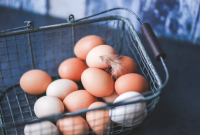Support strong Canadian climate journalism for 2025
For a third year, salmon attempting to cross over a landslide site in British Columbia won’t be able to do so as per usual.
The massive landslide, estimated to have happened in 2018, was discovered in June 2019 in the Fraser River near Big Bar. The event left behind a five-metre waterfall, which the salmon need to swim up to get to their spawning grounds. In past years, salmon have been helicoptered, trucked in and even cannoned over the obstacle.
With another difficult salmon return on the horizon, teams at the Big Bar landslide site are gearing up to observe and transport the fish if needed. A historically low 293,000 sockeye returned to the Fraser in 2019, when water levels were exceptionally high. They’ve been high this year, too, but the Department of Fisheries and Oceans (DFO) says they’re starting to lower.
With 1.3 million sockeye projected to return this year, Gwil Roberts, director of Big Bar landslide response for DFO, is hoping the river level continues to decline, and that its efforts to get salmon across will suffice.
This year, salmon will mostly be reliant on an improved “nature like fishway” to aid them in their travels. The department has spent $131 million to date, and around $6 million in the past few months preparing for the fish arrival — big boulders were dropped into the river to create channels for the salmon to swim through, as well as eddys and other pools for them to rest in. Also in use is a fish wheel, which collects the fish and holds them in the water to be moved past the slide by trucks — if needed.

However, a $176.3-million fish ladder project announced back in December, said to be completed in 2022, has encountered roadblocks. Cold snaps pushed back construction, and Roberts said there isn’t a clear completion date.
Previously, the DFO said the ladder is the only sure and permanent solution to help the salmon pass through the falls. He says the pause leaves the team “concerned.”
“Time is never on our side here. We have been rushing, constantly lacking the time to do the full amount of analysis that we would normally like to do,” he said.
“... The nature-like fishway that exists right now, if it's highly effective, then the pressure can be somewhat relieved on the next set of timelines. If not, then we need to be pushing that much harder to get that permanent solution in place.”

So far, some chinook have started to make their way through Big Bar. Roberts said there have been very few of them so far, with the run looking to be lower than what was expected. He says the early Stuart run, set to start passing through in July, will be able to paint a clearer picture of what the season will look like.
Aaron Hill, executive director of Watershed Watch Salmon Society, says opening up the pathway for fish to pass through the Big Bar slide is vital to their survival.
“The Fraser is by far B.C.’s largest salmon-bearing watershed and the majority of it is being impacted by the slide. That means very few salmon are making it home to major tributaries of the Fraser, like the Nechako, Chilcotin and Quesnel rivers, or to the upper Fraser River, which runs all the way to the Rocky Mountains,” he explained.
“Many of the affected salmon runs are already severely depleted due to climate change, overfishing, salmon farm and hatchery impacts, and habitat damage. The response teams working to get fish through the slide are heroes.”






Comments
Thank you for this update. We can only hope that more salmon get through this year. Kudos to all those working on this project.